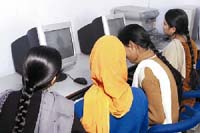Microsoft research: How to help illiterate people use computers
Microsoft Corp.'s Office software and Windows operating system is typically associated with slick "information workers" on the go, using the latest technology to solve complex business problems.

At a company research and development lab in India, however, workers are grappling with a much different problem: How to use technology to help people who cannot read or write, let alone use a computer.
Working with a local advocacy group, Microsoft has developed a prototype of a system that would help connect illiterate domestic workers in India with families seeking their services. The goal is to help the women see how technology can make finding work more efficient, as the first step toward creating broader tools to allow illiterate people to benefit from technological advances.
The software was on display for Microsoft employees Wednesday, as part of Microsoft Research TechFest, an annual gathering of employees from the company's various research and development centers. The researchers, located in China, India, England and the United States, provide the company with a mix of far-flung technology and more practical applications.
Researchers on the Indian project say they have had to overcome their preconceptions about how the technology should work, and why people would want to use it.
Researchers "might go in with an idea of what they need, but once you engage with people you really learn what they need," said P. Anandan, managing director of Microsoft Research India.
The system uses pictures, video and voice commands to tell women what jobs are available, how much the jobs pay and where they are.
Kentaro Toyama, a researcher overseeing the project, said the first big hurdle was to understand what kind of computer images actually made sense to the domestic workers.
A photograph of dirty dishes, for example, was too realistic the women thought those were the actual dishes they were supposed to wash. But a realistic cartoon, with water running over dishes, worked well.
Also, the women associated neighborhoods with landmarks rather than addresses, so an interactive map and verbal directions had to be tweaked to represent that.
Even after extensive revisions, the researchers found that while the women understood how to use the technology, they had trouble seeing why a computerized system for finding work was better than traditional word-of-mouth.
The researchers eventually created a video with popular "Bollywood" movies in mind showing a woman complaining to her spouse that she needed another job, and using the computer to find it. That worked.
The researchers say they are now trying to figure out how to implement the system, since most women who do domestic work don't own computers. One option is to put up a kiosk in a community center, Toyama said, reports AP.
O.Ch.
Subscribe to Pravda.Ru Telegram channel, Facebook, RSS!


